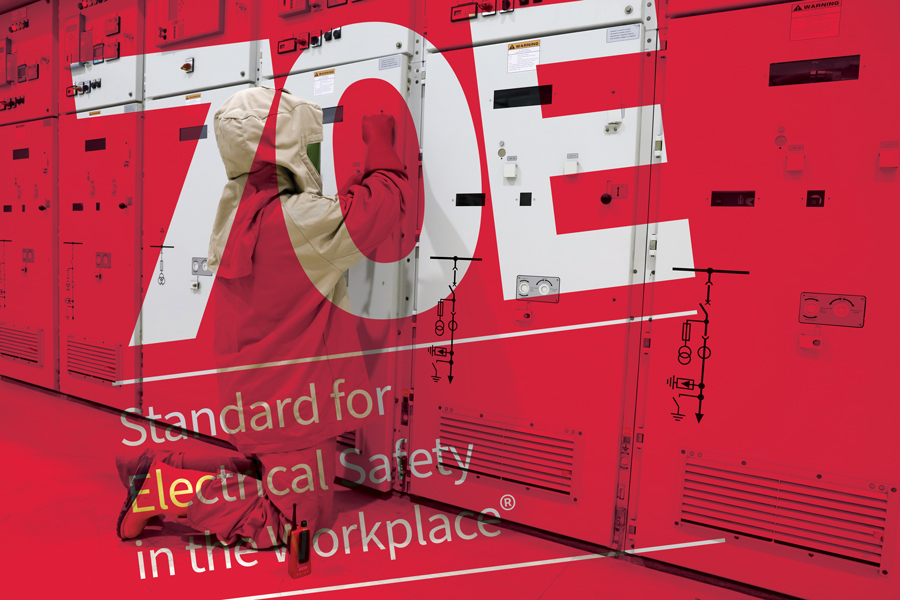

You have probably seen OSHA’s recent guide titled Protecting Employees for Electric-Arc Flash Hazards. If not, you can find it here: https://www.osha.gov/electrical/flash-hazards.
OSHA produced the guide to assist employers and employees in understanding and protecting against arc flash hazards, which brings about an interesting thought about OSHA and its relationship to NFPA 70E.
It reminds us of how important it is to understand the hazards of electricity, and maybe more specifically, how important it is to understand the words and meaning behind NFPA 70E, as OSHA often uses the standard as a reference for their actions related to violations and fines.
Remember, it was OSHA in 1975 that recognized a need to create a standard “to fulfill OSHA’s responsibilities that would still be fully consistent with the NEC.”
Here’s information (in part) related to that, straight from the NFPA 70E Foreword:
In May 1975, the Assistant Secretary of Labor for OSHA responded as follows: “The concept, procedures, and scope of the effort discussed with my staff for preparing the subject standard appear to have great merit, and an apparent need exists for this proposed consensus document which OSHA could consider for promulgation under the provisions of Section 6(b) of the Act. OSHA does have an interest in this effort and believes the proposed standard would serve a useful purpose.”
The Standards Council of NFPA announced the formal appointment of a new electrical standards development committee on January 7, 1976. The Committee on Electrical Safety Requirements for Employee Workplaces was formed to assist OSHA in preparing an electrical safety standard that would serve OSHA’s needs and assist in complying with the requirements of Section 6(b) of the Occupational Safety and Health Act.
When it comes to workplace safety, few industries are exempt from the risks associated with electrical hazards. It’s simply everywhere. OSHA has been a pivotal force in enforcing workplace electrical safety standards, and NFPA 70E plays a significant role in this process.
VIOLATIONS AND FINES
But how does NFPA 70E impact OSHA violations and fines? The 70E, as a comprehensive set of guidelines designed to reduce the risk of electrical injuries and fatalities, is different from OSHA regulations, which are federal law. It should be noted that NFPA 70E is a voluntary standard, although it is widely regarded as a best-practice manual for electrical safety and is frequently used as a benchmark by OSHA inspectors.
HOW OSHA AND NFPA 70E INTERSECT
OSHA enforces workplace safety under the General Duty Clause (Section 5(a)(1) of the Occupational Safety and Health Act, which requires employers to provide a workplace “free from recognized hazards.” It was just said, but it bears repeating, that while NFPA 70E is not federal law, OSHA often uses it to validate and enforce compliance with safety standards….and here’s how.
Validation of Recognized Hazards
OSHA considers NFPA 70E a recognized industry standard. If an employer fails to implement measures outlined in NFPA 70E, OSHA can cite this as evidence of non-compliance with the General Duty Clause. For example, an employer who neglects to conduct an arc flash risk assessment is violating NFPA 70E guidelines, which OSHA can then use as a basis for issuing a citation.
Reference in Citations
OSHA frequently references NFPA 70E in violation citations to specify the standard that employers failed to meet. While the citation itself may list an OSHA regulation, the underlying details often draw directly from NFPA 70E requirements.
Increased Fines
Failure to comply with NFPA 70E can significantly increase OSHA fines. Penalties can range from thousands to hundreds of thousands of dollars, depending on the severity and frequency of violations.
A FEW REAL-WORLD EXAMPLES
Case 1: Employee Killed when Electrocuted (March 2024)
Two serious citations, one for $11,292 and one for $16,131, were issued related to an electrocution on the job site. At 9:30 AM on March 21, 2024, an employee (62-year-old male) was installing a shunt on a pump station. The employee was electrocuted and suffered arc blast burns to the chest, neck, and face. The employee died. (OSHA Inspection Nr: 1739835.015)
Case 2: Employee Killed by Electrocution (January 2024)
A serious citation for $16,131 was related to an electrocution. On January 11, 2024, after completing a safety brief, a four-person crew proceeded with the operations of removing and installing the overhead power lines onto a newly installed 95-foot-long concrete utility pole. The crew consisted of a foreman, Employee #1 (59-year-old male; lineman), Coworker #1 (heavy equipment operator), Coworker #2 (lineman), and Coworker #3 (operator). Coworker #1 was operating a derrick digger to remove the second 65-foot-long concrete pole. The other 65-foot-long concrete pole had been removed from the ground the day prior. Employee #1 was acting as the groundman, directing Coworker #1. Coworkers #2 and #3 were installing the overhead power lines, utilizing an electrical utility bucket truck. The three 115 kV transmission power lines were not energized while performing these operations. At approximately 9:30 AM, after Coworker #1 had the concrete utility pole cleared off the ground, he started to lower the pole into the ground. The boom assembly rotated towards the right, allowing the top end of the utility pole to make contact with an adjacent 46 kV overhead power line, creating an arc flash. Employee #1 was in contact with the utility pole, which had the grounding cable still attached, suffering an electrocution. Employee #1 was killed. (OSHA Inspection Nr: 1720741.015)
Case 3: Employee Killed in Arc Flash while Troubleshooting Switch (October 2023)
Two serious citations, one for $11,292 and one for $0, were issued related to an electrocution and arc flash fatality. At 10:00 AM on October 22, 2023, an employee (25-year-old, male) working as an electrician for a natural gas distribution company was troubleshooting switchgear in the motor control center. The employee was working with three coworkers who worked for other employers. The employee made contact with live electrical equipment and an arc flash occurred. The employee died from electrocution, burns, and smoke inhalation. (OSHA Inspection Nr: 1705435.015)
WHY 70E COMPLIANCE MATTERS
You should not only worry about the money associated with the consequences of non-compliance with NFPA 70E and OSHA regulations because it extends beyond monetary fines. Employers who neglect electrical safety put their workers at risk of severe injury or death and face reputational damage in the industry with their customers and their competitors. As always, they risk potential litigation…not only against the company but possibly individuals! Here’s why compliance is critical.
Protecting Employees
The primary goal of NFPA 70E is to safeguard employees from electrical hazards. Implementing its guidelines not only ensures legal compliance but also fosters a safer workplace.
Reducing Financial Risks
OSHA fines for electrical safety violations can be steep, often exceeding six figures. Adhering to NFPA 70E minimizes the likelihood of citations and the financial burden of non-compliance.
Enhancing Productivity
A safe work environment reduces downtime caused by accidents, leading to improved productivity and employee morale.
Avoiding Legal Liabilities
In the event of an incident, adherence to NFPA 70E can serve as a defense against claims of negligence and OSHA violations.
WHAT CAN YOU DO?
So what can you as an employer do to ensure compliance with NFPA 70E and meet the intent of OSHA’s rules and requirements? Several basic things, actually. If you don’t do anything else, make sure you are at least doing these five things:
- Conduct risk assessments: Regularly evaluate arc flash and electrical shock risks.
- Implement LOTO procedures: Ensure all energy sources are properly de-energized before maintenance.
- Provide PPE: Equip employees with NFPA 70E-compliant protective gear.
- Offer training: Train employees on electrical safety practices and the specific hazards of their work environment.
- Document procedures: Maintain clear, written policies and procedures for electrical safety.
CONCLUSION
The NFPA 70E standard plays a vital role in shaping workplace safety practices and serves as a cornerstone for OSHA’s enforcement efforts. While not legally binding, it is widely regarded as the gold standard for electrical safety and often forms the basis for OSHA citations and fines.
By understanding the interplay between NFPA 70E and OSHA regulations, employers can better protect their workforce, avoid costly penalties, and create a culture of safety. Ultimately, compliance is not just about avoiding fines; it’s about safeguarding lives and building a safer future for everyone.
Remember — Before working on it, turn it off. And you know this: Test Before Touch!

Ron Widup is the Vice Chairman, Board of Directors, and Senior Advisor, Technical Services for Shermco Industries and has been with Shermco since 1983. He is a member of the NETA Board of Directors and Standards Review Council; a Principal member of the Technical Committee on Standard for Electrical Safety in the Workplace (NFPA 70E); Principal member of the National Electrical Code (NFPA 70) Code Panel 11; Principal member and Chairman of the Technical Committee on Standard for Competency of Third-Party Evaluation Bodies (NFPA 790); Principal member and Chairman of the Technical Committee on Recommended Practice and Procedures for Unlabeled Electrical Equipment Evaluation (NFPA 791); a Principal member of the Technical Committee Standard for Electrical Equipment Maintenance (NFPA 70B); and Vice Chair for IEEE Std. 3007.3, Recommended Practice for Electrical Safety in Industrial and Commercial Power Systems. He is a member of the Texas State Technical College System (TSTC) Board of Regents, a NETA Certified Level 4 Senior Test Technician, State of Texas Journeyman Electrician, a member of the IEEE Standards Association, an Inspector Member of the International Association of Electrical Inspectors, and an NFPA Certified Electrical Safety Compliance Professional (CESCP).